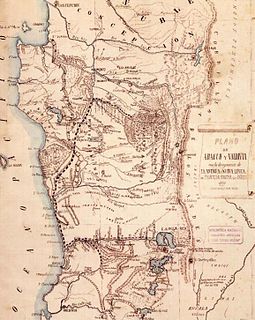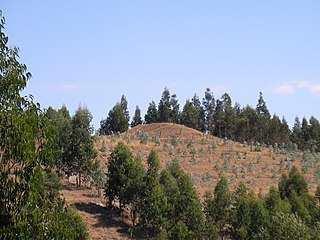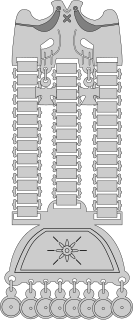 W
WAraucanía or Araucana was the Spanish name given to the region of Chile inhabited by the Mapuche peoples known as the Moluche in the 18th century. Prior to the Spanish conquest of Chile, the lands of the Moluche lay between the Itata River and Toltén River.
 W
WThe Kingdom of Araucanía and Patagonia was an unrecognized state declared by two ordinances on November 17, 1860 and November 20, 1860 from Antoine de Tounens, a French lawyer and adventurer, who claimed that the regions of Araucanía and eastern Patagonia did not depend of any other states and proclaimed himself king of Araucanía and Patagonia. He had the support of some Mapuche lonkos around a small area in Araucanía, who thought he could help them maintain their independence from the Chilean and Argentinian governments.
 W
WThe Arauco War was a long-running conflict between colonial Spaniards and the Mapuche people, mostly fought in the Araucanía. The conflict begun at first as a reaction to the Spanish conquest attempt establishing cities and forcing Mapuches into servitude. It subsequently evolved over time into phases, drawn-out sieges, slave-hunting expeditions, pillaging raids, punitive expeditions, and renewed Spanish attempts to secure lost territories. Abduction of women and war rape was common on both sides.
 W
WThe Army of Arauco was a professional army in the service of the kings of Spain that was based in Spanish-Mapuche frontier, south-central Chile, during the 16th to 19th centuries. It was notable for being a rare example of a standing army in the Americas. The army was established after the disastrous Destruction of the Seven Cities (1598–1604) to fight in the Arauco War against anti-Spanish Mapuche coalitions. The army was financed by silver from Potosí, in a payment called Real Situado.
 W
WBanditry was a considerable phenomenon in 19th century and early 20th century Central Chile and Araucanía. Many bandits achieved legendary status for their brutality and others for being regarded folk heroes. The bandits usually preyed on haciendas and their inquilinos.
 W
WThe Battle of the Maule was fought between a coalition of Mapuche people of Chile and the Inca Empire of Peru. Traditionally this battle is held to have occurred near what is now Maule River, in Central Chile. The account of Garcilaso de la Vega depicts the three-day battle, which is generally believed to have occurred in the reign of Tupac Inca Yupanqui.
 W
WElisa Bravo Jaramillo de Bañados was a passenger on Joven Daniel when this ship was wrecked on the coast of Araucanía, south-central Chile in 1849. She was rumoured to have survived and held captive by local Mapuches; her supposed plight caused a stir and was even the subject of two paintings by Raymond Monvoisin.
 W
WThe cuel are Mapuche-built tumulus. The best known cuels are near the localities of Purén and Lumaco in Araucanía, south-central Chile. The first significant studies of the cuel were published by Tom Dillehay and José Saavedra in 2003 and 2007. The word cuel is a neologism formed from the mapudungun word kuel, meaning boundary marker according to the 18th century dictionary of Andrés Febrés.
 W
WThe Dutch expedition to Valdivia was a naval expedition, commanded by Hendrik Brouwer, sent by the Dutch Republic in 1643 to establish a base of operations and a trading post on the southern coast of Chile. With Spain and the Dutch Republic at war, the Dutch wished to take over the ruins of the abandoned Spanish city of Valdivia. The expedition sacked the Spanish settlements of Carelmapu and Castro in the Chiloé Archipelago before sailing to Valdivia, having the initial support of the local natives. The Dutch arrived in Valdivia on 24 August 1643 and named the colony Brouwershaven after Brouwer, who had died several weeks earlier. The short-lived colony was abandoned on 28 October 1643. Nevertheless, the occupation caused great alarm among Spanish authorities. The Spanish resettled Valdivia and began the construction of an extensive network of fortifications in 1645 to prevent a similar intrusion. Although contemporaries considered the possibility of a new incursion, the expedition was the last one undertaken by the Dutch on the west coast of the Americas.
 W
WJoven Daniel was a brigantine of the Chilean Navy that entered service in 1838 serving as transport in Manuel Bulnes' expedition to Peru during the War of the Confederation. The ship became later known for its wreck off the coast of Araucanía in 1849. As it wrecked in territory outside Chilean government control. Chilean authorities struggled to elucidate the fate of possible survivors amidst inter-indigenous accusations of looting, murder and other atrocitities among local Mapuche. The events spinning off the wreckage fueled strong anti-Mapuche sentiments in Chilean society contributing years later to the Chilean resolution to invade their hithereto independent territories.
 W
WMalón is the name given to plunder raids carried out by Mapuche warriors, who rode horses into Spanish, Chilean and Argentine territories from the 17th to the 19th centuries, as well as to their attacks on rival Mapuche factions. Historian Juan Ignacio Molina said the Mapuche considered the malón to be a means of obtaining justice:The injured family often assumes the right of pursuing the aggressor or his relations, and of punishing them. From this abuse are derived the denominations and distinctions, so much used in their jurisprudence, of genguerin, genguman, gerila, &c. denoting the principal connections of the aggressor, of the injured, or the deceased, who are supposed to be authorized, by the laws of nature, to support by force the rights of their relatives. When those who are at enmity have a considerable number of adherents, they mutually make incursions upon each other's possessions, where they destroy or burn all that they cannot carry off. These private quarrels, called malones, resemble much the feuds of the ancient Germans, and are very dreadful when the Ulmenes are concerned, in which case they become real civil wars. But it must be acknowledged that they are generally unaccompanied with the effusion of blood, and are confined to pillage alone. This people, notwithstanding their propensity to violence, rarely employ arms in their private quarrels, but decide them with the fist or with the club.
 W
WMapuche silverwork is one of the best known aspects of Mapuche material culture. The adornments have been subject to changes in fashion but some designs have resisted change.